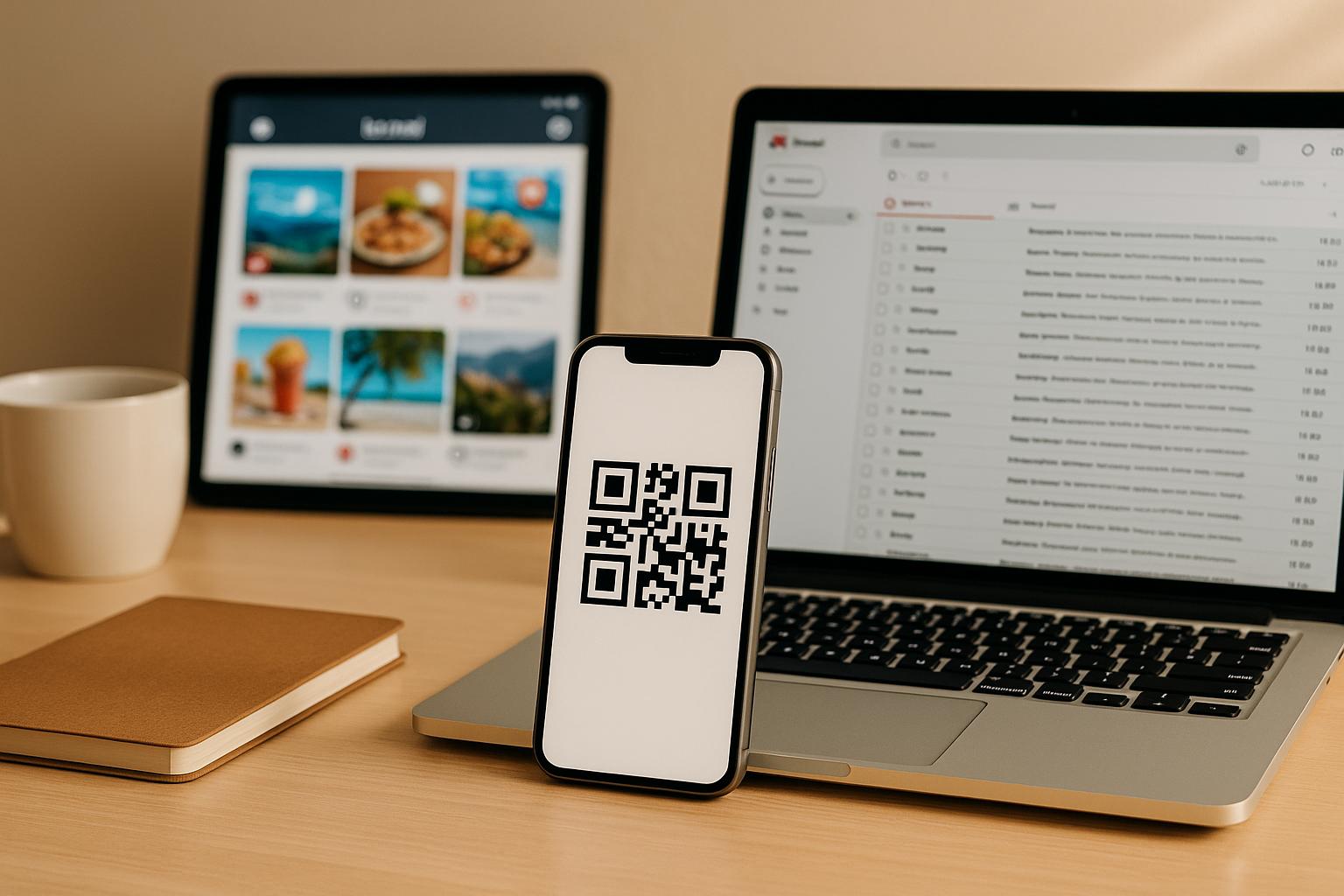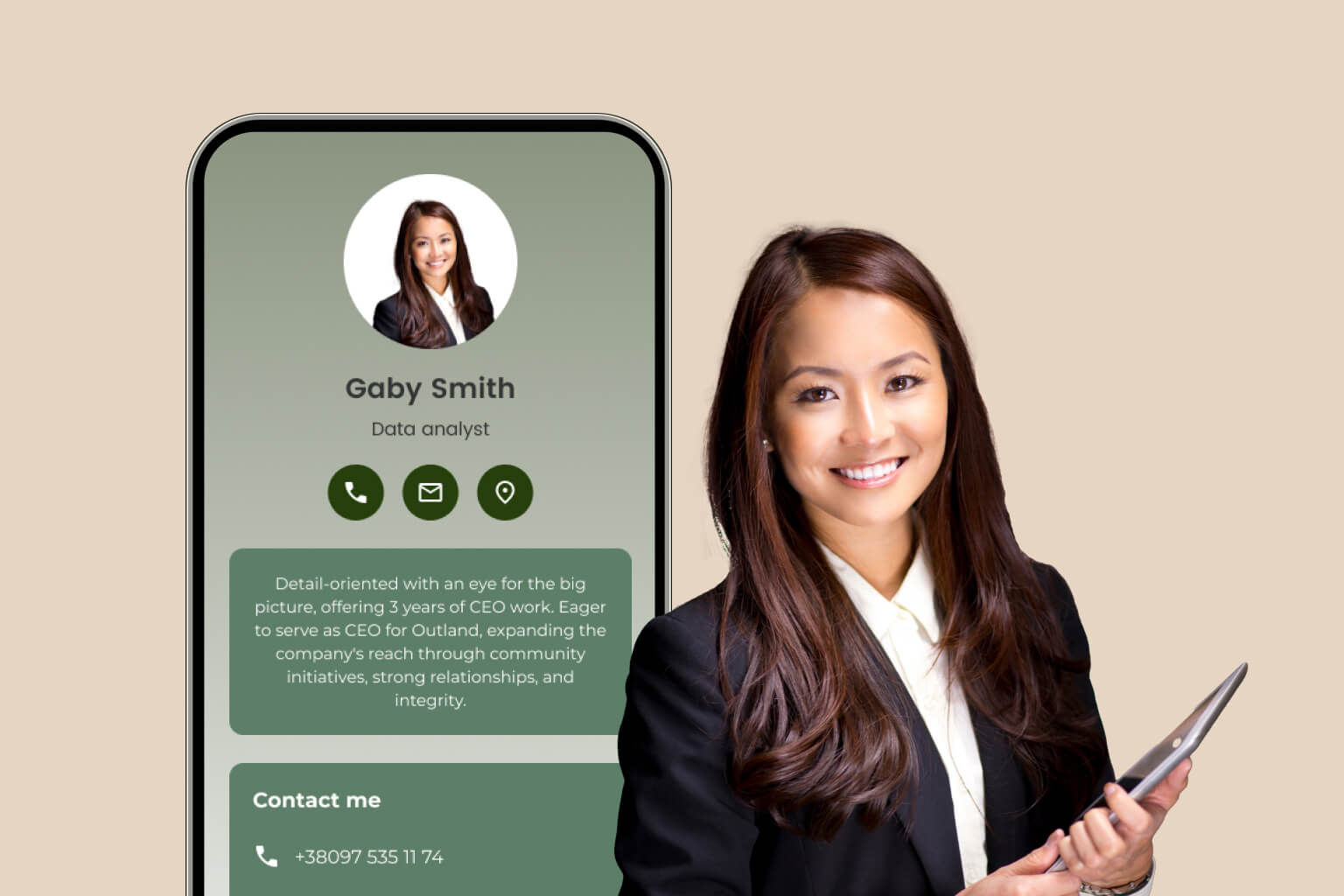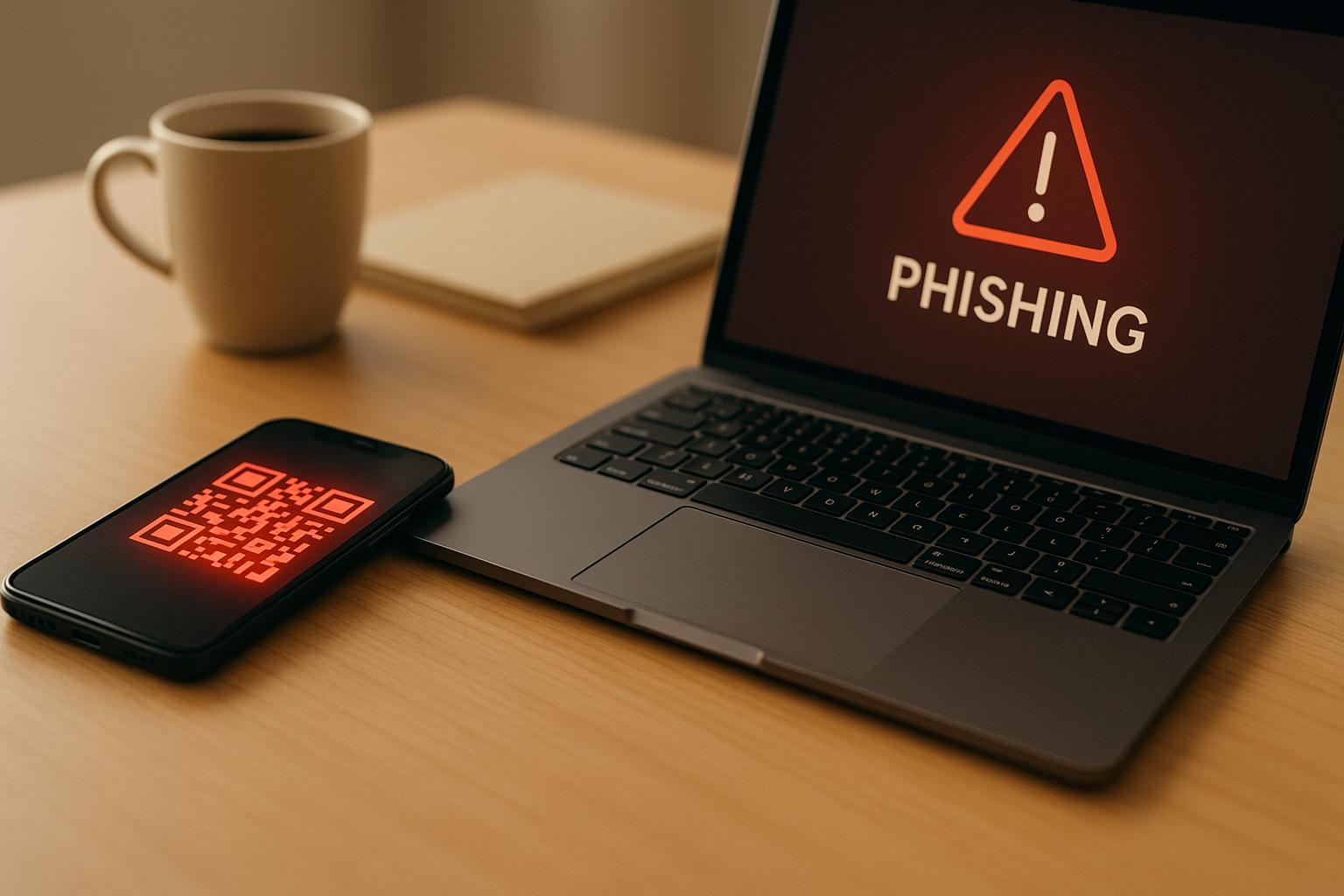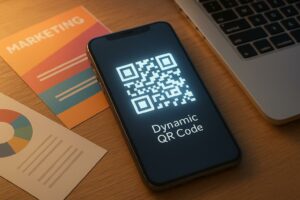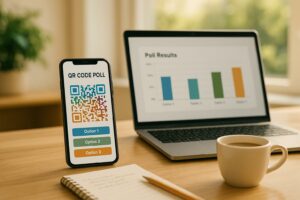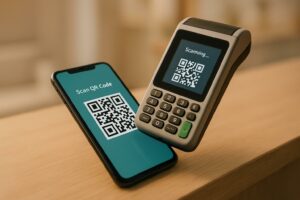QR codes simplify how businesses link social media and email marketing, creating seamless customer journeys. They let users quickly move between platforms – like scanning a code on Instagram to sign up for an email list or clicking a QR code in an email to view social media content.
Key Takeaways:
- Why it Matters: Social media builds awareness, while email drives personalized sales. Together, they amplify results.
- How QR Codes Help: QR codes remove friction, allowing instant transitions between platforms and boosting engagement.
- Benefits:
- Grow email lists directly from social media.
- Use QR codes in emails to drive traffic to social media or product pages.
- Track and optimize campaigns with dynamic QR codes and analytics.
Quick Stats:
- $36 ROI for every $1 spent on email marketing.
- 88% growth in QR code usage in retail year-over-year.
- 100 million smartphone users will scan QR codes by 2025.
QR codes are a powerful tool to connect these channels, improve engagement, and create a smoother customer experience.
How to Collect Email Opt ins with QR Codes
Why Connecting Social Media and Email Marketing Matters
Many businesses treat social media and email marketing as entirely separate channels, missing out on the benefits of combining their strengths. When these platforms work together, they create a powerful synergy that enhances engagement, broadens your audience, and improves results on both fronts. Let’s dive into how blending these two channels can deliver measurable outcomes.
Using the Strengths of Both Channels
Social media and email marketing each bring unique advantages to the table. Social media is perfect for building brand awareness and reaching new audiences, while email marketing excels at delivering targeted messages and driving sales.
The numbers speak for themselves: email marketing boasts an impressive $38 return for every $1 spent, with an average conversion rate of 8.17%. Meanwhile, social media, with its 5% conversion rate, offers unmatched viral potential and visual appeal. Rather than choosing one channel over the other, savvy marketers combine the two to amplify their impact.
Consumer preferences highlight why this integration works so well. While 37% of people prefer email for brand updates, social media ranks as the third most-preferred channel at 33%. Additionally, 38.5% of customers list social media as their second choice for updates on products and services. This creates an ideal opportunity: use social media to attract and engage new audiences, then encourage them to join your email list for more personalized communication. Interestingly, email subscribers are 3.9 times more likely to share content on social media, creating a feedback loop that benefits both platforms.
Creating Smooth Customer Journeys
QR codes offer a seamless way to connect social media discovery with email engagement. They create direct paths for customers to stay engaged with your brand throughout their journey.
For example, someone who discovers your Instagram post can quickly join your email list by scanning a QR code, gaining access to exclusive offers and updates. Later, a well-timed email with a special discount can encourage them to make a purchase.
Similarly, email subscribers can easily access your latest social media content via QR codes, while social followers can join your email list for special perks. This interconnected approach ensures a smooth and unified customer experience across platforms.
Tracking Cross-Platform Engagement
Dynamic QR codes make it possible to track customer interactions across both email and social media in real time. You can monitor scans by browser, location, and other metrics to gain deeper insights into your audience.
These QR codes are also perfect for A/B testing. For instance, you can test different designs or messaging to see which drives more scans. This data helps you fine-tune both your email campaigns and social media content based on actual user behavior.
Consider the example of Elle Boutique, a fashion retailer that wanted to boost mobile app downloads due to higher conversion rates on mobile devices. By adding coupon QR codes to email campaigns, they successfully directed users to shop through their mobile app, increasing sales.
Tracking email scans alongside social media engagement provides a complete view of customer behavior. This combined data allows for better targeting and higher marketing ROI. By linking both channels, you can create personalized customer experiences that wouldn’t be achievable with just one platform.
Using an email QR code generator simplifies the process of creating trackable links between your email campaigns and social media content. Whether you’re running campaigns for a marketing agency or building customer lists for an e-commerce business, this tool makes integration easy and effective.
How to use QR codes in email marketing
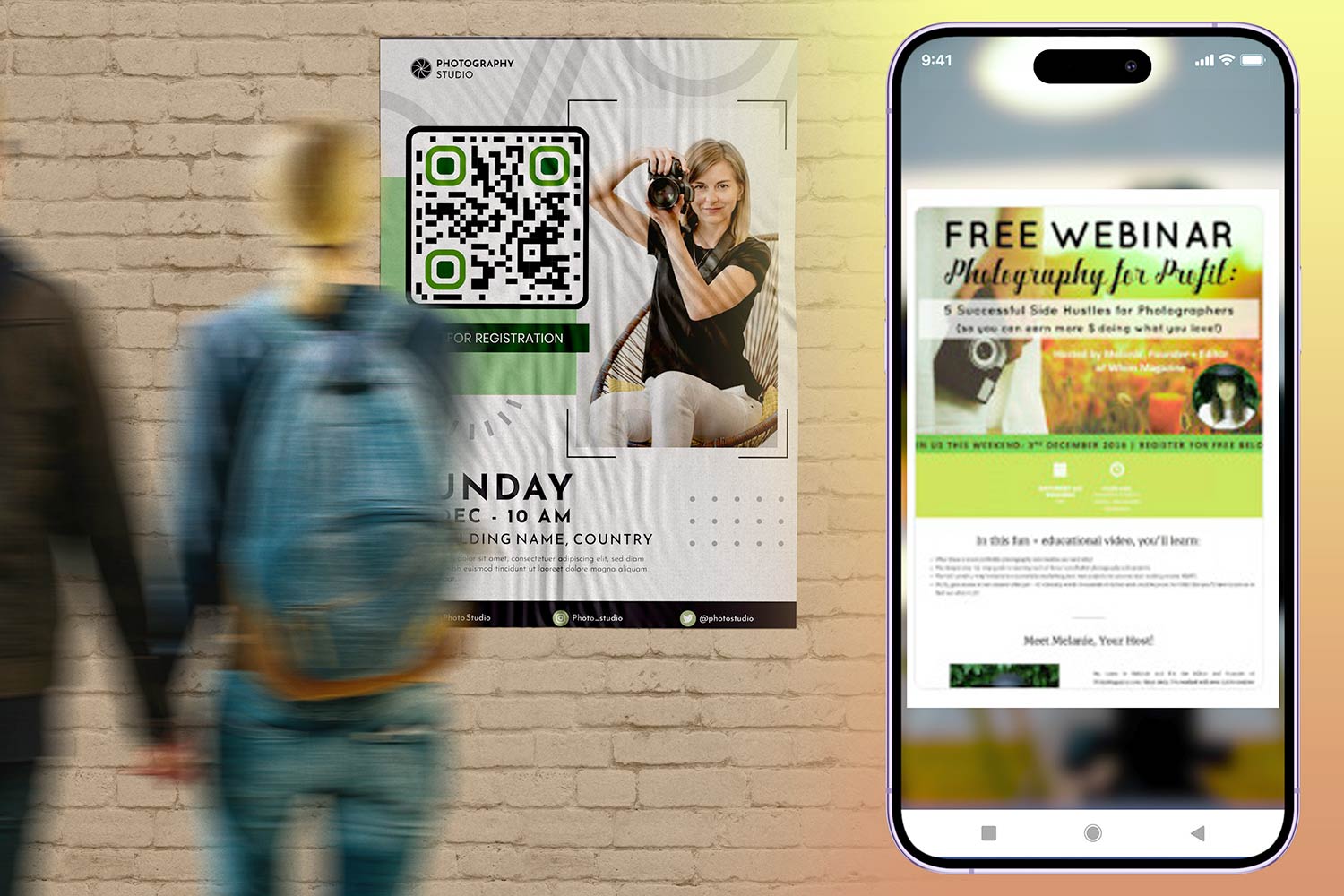 Email marketing continues to be one of the most reliable ways to connect with your audience, offering a $36 return for every dollar spent. With 93% of B2B marketers relying on email to share content and 59% of consumers saying marketing emails influence their buying decisions, incorporating QR codes into your email strategy can take engagement and conversions to the next level.
Email marketing continues to be one of the most reliable ways to connect with your audience, offering a $36 return for every dollar spent. With 93% of B2B marketers relying on email to share content and 59% of consumers saying marketing emails influence their buying decisions, incorporating QR codes into your email strategy can take engagement and conversions to the next level.
QR codes transform static emails into interactive experiences, encouraging immediate action. Whether you’re driving traffic to your website, promoting app downloads, or growing your social media following, QR codes make it simple – just scan and go. This approach ties email campaigns seamlessly into your broader cross-platform marketing efforts.
Building email lists through social media QR codes
Social media is a goldmine for reaching potential subscribers, and QR codes make it even easier to grow your email list. With 73% of millennials preferring email communication from businesses, turning social media followers into email subscribers opens up a direct, personalized communication channel.
The trick is to make the process as smooth as possible. Add QR codes to your Instagram Stories, Facebook posts, or Twitter bio, linking directly to your email signup form. To encourage signups, offer perks like exclusive discounts, free e-books, or early access to new products for those who join via the QR code.
Take eGo Gaming Studios as an example. They used App Store QR codes in their email campaigns, social media posts, and landing pages, helping desktop users easily download their mobile app. This multi-platform strategy ensured users could access the app from wherever they encountered the QR code.
Dynamic QR codes are especially useful for tracking which social platforms drive the most signups. This data lets you focus on what’s working and fine-tune your messaging for better results.
Another idea? Create a social media QR code generator campaign that links to a landing page featuring all your social profiles alongside an email signup form. This gives users multiple ways to connect with your brand while keeping email list growth front and center.
Making emails more interactive with QR codes
Let’s face it: emails can sometimes feel a bit static. QR codes change that by turning your emails into interactive, action-oriented tools. With the average email open rate across industries at 21.5%, QR codes can boost click-through rates by making engagement as easy as a quick scan.
This is especially effective for mobile users, who make up the bulk of email readers. Instead of typing long URLs or navigating through menus, they can scan a QR code to instantly access product pages, videos, or special offers.
Here are some practical ways to use QR codes to make your emails more engaging:
- Product showcases: Link QR codes to featured products, giving users instant access to details, reviews, or purchase options. This is perfect for e-commerce brands launching new items or running limited-time sales.
- Video content: Use a video QR code generator to share product demos, customer testimonials, or behind-the-scenes footage. Videos are especially helpful for explaining complex products.
- Event registration: Add QR codes that lead to event registration forms, calendar invites, or venue details. This makes signing up quick and reduces drop-offs.
- Social media integration: Include QR codes that link to your latest social posts, encouraging recipients to follow your accounts or share content with their networks.
When adding QR codes to your emails, make sure they’re large enough to scan easily and include clear instructions on how to use them. Always provide a backup link for users who can’t scan the code, and test everything on different devices before launching your campaign.
"Email has an ability many channels don’t: creating valuable, personal touches – at scale." – David Newman
Using QR Codes for Social Media Marketing
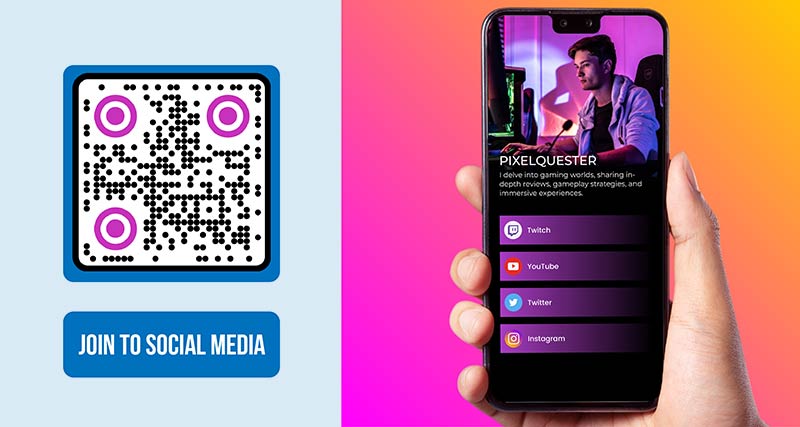 QR codes have become a game-changer for bridging the gap between social media and actionable engagement. Social media platforms offer unmatched reach, but turning likes and shares into meaningful actions can be tricky. QR codes simplify this process, providing users with an instant way to engage. With eMarketer predicting that 99.5 million U.S. smartphone users will scan a QR code by 2025, marketers have a powerful tool to drive conversions directly from social media.
QR codes have become a game-changer for bridging the gap between social media and actionable engagement. Social media platforms offer unmatched reach, but turning likes and shares into meaningful actions can be tricky. QR codes simplify this process, providing users with an instant way to engage. With eMarketer predicting that 99.5 million U.S. smartphone users will scan a QR code by 2025, marketers have a powerful tool to drive conversions directly from social media.
By integrating QR codes into your social posts, you can guide users to your latest blog, encourage app downloads, or grow your email list. This instant connection is especially effective when using dynamic QR codes, which can adapt to the needs of your campaigns in real time.
Dynamic QR Codes for Campaign Flexibility
While static QR codes work for links that don’t change, social media thrives on adaptability. Trends shift quickly, and campaigns often require adjustments on the fly. That’s where dynamic QR codes step in, offering flexibility that static codes simply can’t match.
Dynamic QR codes allow you to update the destination URL without altering the code itself. This means you can use the same QR code across platforms while tweaking campaign goals based on performance metrics.
"Dynamic QR codes are like the Swiss Army knife of marketing. They’re: Editable – Need to change your campaign URL? No reprints are required. Trackable – Go down to the scan and see what’s working and what’s not. Flexible – QR codes can live and lead anywhere from packaging to guerrilla art." – Benjamin Claeys, Author
Take Cadbury’s Christmas campaign as an example. They used dynamic QR codes on posters and street signs, enabling users to send chocolate bars to loved ones. As the campaign progressed, Cadbury updated links to reflect inventory changes, new promotions, and regional availability – all without reprinting materials.
Similarly, Jupiler, a Belgian beer brand, added dynamic QR codes to their cans during Euro 2024. Fans could scan them to win prizes like exclusive merchandise, match tickets, or behind-the-scenes experiences. The ability to update prizes throughout the tournament made their campaign more engaging and responsive.
Dynamic QR codes also shine in A/B testing. Start with one landing page, then switch to another mid-campaign to compare conversion rates. This real-time flexibility makes them indispensable for data-driven social media strategies.
Tracking Social Media Engagement with QR Codes
Accurate tracking is key to understanding how QR codes perform on social media. Using UTM parameters consistently across campaigns helps you identify which platform delivers better results. For instance, you’ll know whether Instagram or Facebook drives more scans and conversions.
Melitta used QR codes to tell their product story, tracking which parts of their brand narrative resonated most with different audience segments. ISDIN, a skincare brand, took it a step further by creating custom landing pages linked to QR codes, using real-time dashboards to collect and analyze data.
Here’s what to track with QR codes on social media:
- Scan frequency and timing: Determine when your audience is most active. If scans peak during lunch hours, schedule posts accordingly.
- Device and location data: Find out whether your audience uses iOS or Android and identify regions with the highest engagement. This helps refine your content and ad targeting.
- Conversion tracking: Measure what happens after the scan. Are users signing up for newsletters, making purchases, or just browsing? This data helps you optimize landing pages and calls-to-action.
Set aside time each week to review analytics. Spotting patterns in user behavior allows you to tweak your campaigns and improve results over time. These insights also help you design offers that resonate more effectively with your audience.
Creating Exclusive Offers and Events
QR codes are perfect for turning social interactions into tangible results through exclusive offers. With projections of over 5.3 million QR code coupon redemptions by 2024 and 60% of customers preferring QR code discounts, this strategy is a no-brainer for driving loyalty and engagement.
The appeal lies in combining social proof with instant gratification. For example, an Instagram Story featuring an exclusive deal linked to a QR code makes it easy for followers to act immediately.
McDonald’s tapped into this strategy with their WcDonalds campaign. Partnering with Studio Pierrot and Acky Bright, they created QR codes that unlocked anime mini-episodes, manga, and a new chili sauce. This exclusive content, accessible only through QR scans, generated buzz and urgency.
Event registration is another area where QR codes shine. Instead of directing followers to lengthy forms, create QR codes that link to simplified sign-up pages. Event planners often pair these codes with influencer giveaways or hashtag contests to amplify reach and generate excitement.
"With a swift scan, your audience can access real-time content, interact with speakers, or even enter competitions." – Tim Smith, Media Manager, DialMyCalls
The secret to success lies in offering real value. Early bird discounts, behind-the-scenes content, or limited-time access to new products all work well. And don’t forget to use clear, compelling calls-to-action – phrases like "Scan to Win!" or "Exclusive Access Inside" perform much better than generic "Scan Here" messages.
For marketing agencies juggling multiple client campaigns, QR codes provide a scalable way to deliver unique experiences for each brand while maintaining consistent tracking and analytics.
sbb-itb-74874c9
How Pageloot Simplifies QR Code Campaigns

Handling QR codes across multiple platforms like social media and email can feel overwhelming. Pageloot takes the hassle out of the process by offering a one-stop platform for everything from QR code creation to performance tracking. This makes it easier to maintain consistency and clarity across your campaigns, no matter where they’re running.
Customization for Consistent Branding
Keeping your branding consistent across platforms isn’t just a nice-to-have – it’s essential for building recognition and trust. In fact, syncing your brand’s colors and logos can improve recognition by up to 80%. Pageloot makes this straightforward by allowing you to design QR codes that perfectly match your brand identity.
With Pageloot, you can customize QR codes to include your company logo, match your brand’s color palette, and choose from professionally designed templates. Whether it’s a QR code on an Instagram post or in an email newsletter, your audience will see the same cohesive branding.
To ensure precision, Pageloot offers a hex color editor, so your QR codes align seamlessly with your existing materials. Whether you’re printing them on business cards, displaying them on posters, or using them in digital campaigns, the result is a unified brand experience.
For e-commerce campaigns that span multiple touchpoints, this level of consistency is especially important. Whether customers encounter your QR code on social media, in an email, or on product packaging, they’ll immediately recognize it as part of your brand.
Real-Time Analytics and Insights
Knowing how your QR codes perform across different channels is key to fine-tuning your marketing strategy. Pageloot’s analytics dashboard gives you detailed insights to help you make smarter, data-driven decisions.
You can track metrics like scan frequency, timing, device types, and geographic locations. This is particularly useful for campaigns running simultaneously on platforms like social media and email. For instance, you can identify which platform is driving more engagement and adjust your efforts accordingly.
Pageloot’s real-time analytics also let you spot trends as they happen. For example, if scans for an Instagram QR code spike in the evening, you can tweak your posting schedule to maximize visibility. Similarly, if your email QR codes perform better on certain days, you can plan your sends for those peak times.
Location data is especially helpful for businesses with physical locations. Take a restaurant, for example – it can use scan data to pinpoint which neighborhoods are engaging most with its social media campaigns and target local ads more effectively.
Dynamic QR Codes for Multi-Platform Campaigns
Static QR codes are fine for fixed links, but when you’re managing campaigns across multiple platforms, you need flexibility. That’s where dynamic QR codes come in. These codes allow you to update destinations as your campaign evolves, making them a game-changer for marketers.
With Pageloot’s dynamic QR code generator, you can use the same QR code across all platforms and update its destination whenever needed. For instance, start by linking to an email landing page, then switch to a contest page as the campaign progresses – no need to reprint or redesign materials.
The use of QR codes has skyrocketed, with a 238.06% increase in creation since 2021. Dynamic QR codes take this to the next level by allowing you to track key metrics like location, time, date of scan, and overall click-through rates.
This combination of flexibility and analytics lets you adapt your campaigns on the fly. Imagine promoting a product launch through both email and social media. Initially, your email might link to a detailed product page, while your social posts send users to a video. As the campaign evolves, you can redirect both to customer testimonials or special offers, depending on what resonates most with your audience.
Dynamic QR codes also make A/B testing a breeze. You can experiment with different landing pages and instantly update them based on performance data. In fast-paced environments like social media, this ability to pivot quickly is invaluable. By integrating these tools, Pageloot ensures your campaigns stay agile while delivering a seamless experience for your audience.
Best Practices for Effective QR Code Campaigns
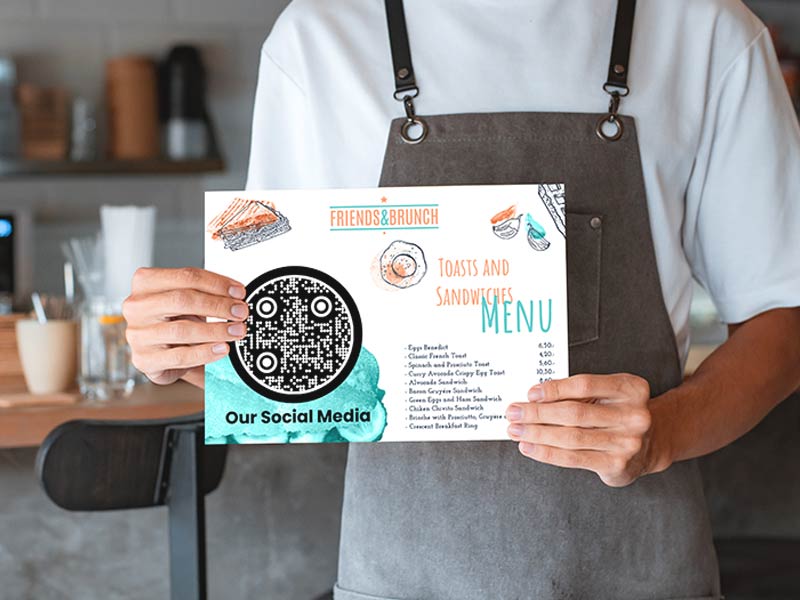 Creating an effective QR code campaign isn’t just about slapping a code onto your marketing materials. It’s about crafting a seamless journey from scan to action. The difference between a campaign that succeeds and one that fizzles often lies in following a few essential strategies.
Creating an effective QR code campaign isn’t just about slapping a code onto your marketing materials. It’s about crafting a seamless journey from scan to action. The difference between a campaign that succeeds and one that fizzles often lies in following a few essential strategies.
Clear Calls-to-Action
A QR code without context is like a door without a sign – it doesn’t invite people in. Adding a clear and engaging call-to-action (CTA) can turn casual interest into actual engagement.
"When people see an odd-looking square, they aren’t necessarily motivated to take action. But when it says, Scan me, they’re much more likely to follow through. If it says, ‘Win a prize’ or ‘Learn more,’ I see about 80% more people entering that digital door." – Benjamin Claeys, CEO of QR TIGER
The stats back it up. Businesses that optimized their CTAs saw an 80% boost in website performance and conversions, with QR code scans skyrocketing by 443% in one quarter alone.
Keep your CTAs short and specific – four words or fewer works best. Instead of generic phrases like "Scan here", go for something that piques interest, such as:
- "Get your exclusive discount"
- "Discover behind-the-scenes content"
- "Join our VIP list"
Some brands have mastered this approach. For example, L’Oreal Paris used the CTA "Try it on now" in their virtual makeup try-on campaign, leading to a significant jump in conversions. Victoria’s Secret took it a step further, designing QR codes shaped like lingerie silhouettes and pairing them with the phrase "Reveal the Secret."
Experiment with different CTAs to see what resonates with your audience. Tools like a social media QR code generator can help you create multiple versions for A/B testing. Once you’ve nailed the CTA, the next step is ensuring a smooth mobile experience.
Mobile-Optimized Destinations
Most QR codes are scanned using smartphones, so it’s critical that the destinations they lead to are mobile-friendly. A poor mobile experience can frustrate users and derail your campaign. In fact, Google prioritizes mobile-optimized sites in search rankings, and users tend to abandon pages that load slowly or display poorly.
To create an effective mobile experience:
- Use a simple, single-column layout for easy scrolling.
- Compress images and videos to reduce loading times.
- Limit forms to three fields or fewer if collecting information.
Before launching, test your QR codes on various devices and under different conditions – think varying lighting and scanning distances.
If your campaign spans multiple platforms, such as email and social media, ensure the mobile experience is consistent across all touchpoints. Whether someone scans your QR code from an Instagram story or an email, they should encounter the same seamless journey. Tools like Pageloot’s QR code generator make it easy to create codes that work across devices and platforms, ensuring a unified experience.
Consistent Messaging Across Platforms
Once you’ve nailed your CTAs and mobile optimization, the next step is to maintain consistent messaging across all platforms. Whether your QR code appears in an email, on social media, or on a business card, the messaging should align to build trust and recognition. Inconsistent messaging can confuse your audience and weaken your brand, while consistent messaging can increase revenue by up to 23%.
Consistency goes beyond just using the same colors and logos (though visual consistency can boost brand recognition by 80%). Your tone, value propositions, and core messages should remain uniform across all channels.
"Branding is the process of connecting good strategy with good creativity." – Marty Neumeier, author of The Brand Gap
To achieve this, develop detailed brand guidelines that cover both visuals and messaging. These guidelines ensure that every touchpoint reinforces your brand identity. For example, if a customer encounters your QR code on a business card and later sees it in an email, they should immediately recognize it as part of the same campaign.
Use a content calendar to plan your campaigns and keep messaging aligned across platforms. Regular audits can help you identify and fix inconsistencies. Training your team to follow brand guidelines ensures everyone is on the same page, especially for campaigns that span multiple channels.
For businesses like restaurants or retail stores, consistent messaging across QR codes on menus, social media, and email campaigns creates a cohesive brand experience that customers trust and remember. This attention to detail can lead to measurable growth – brands with strong consistency often see revenue increase by 10% or more.
Conclusion
QR codes serve as a powerful link between social media and email marketing. By connecting these platforms, businesses can create a seamless customer journey that encourages both engagement and conversions.
Each platform brings its own strengths to the table – email is ideal for personalized, direct communication, while social media shines with its viral reach and real-time interaction. Together, they form a strategy that amplifies the best of both worlds, creating a unified and effective marketing approach.
Dynamic QR codes add another layer of flexibility, allowing businesses to update destinations as campaigns evolve. This adaptability is especially important for multi-platform marketing efforts, where being able to adjust quickly can make all the difference.
On top of that, analytics provide essential insights by tracking scan rates, user behavior, and engagement patterns. This data helps fine-tune messaging and targeting, ensuring that both email and social media campaigns are as effective as possible.
For businesses looking to implement these strategies, tools like Pageloot simplify the process. With features such as advanced customization, real-time analytics, and over 25 QR code types, you can easily create QR codes tailored to your campaign needs. Whether you’re linking email marketing to social platforms or crafting integrated experiences for e-commerce and marketing agencies, these tools make it easy to deliver a unified customer experience.
The future of marketing lies in connecting with customers wherever they are. QR codes make this possible, transforming separate marketing channels into a cohesive strategy that delivers measurable results. By integrating QR codes across email and social platforms, businesses can create a seamless and engaging customer journey.
FAQs
How can QR codes help businesses connect social media and email marketing?
QR codes make it easier for businesses to connect their social media efforts with email marketing by acting as a direct link between platforms. With just a quick scan, users can instantly access a business’s social media profiles, follow their pages, or open email sign-up forms. This eliminates the hassle of manual searches or extra clicks, streamlining the process and encouraging immediate interaction.
Advanced tools like dynamic QR codes and real-time analytics take things a step further. These features let businesses monitor user activity, offering insights to refine campaigns and better understand their audience. Plus, the ability to customize QR codes with logos and brand colors ensures they not only stand out but also reinforce brand identity. In a world increasingly leaning toward contactless options, these tools help marketers design campaigns that are efficient, tailored, and easy for users to engage with.
What are dynamic QR codes and why are they useful for marketing across platforms?
Dynamic QR codes are a game-changer because they let you tweak the linked content even after printing. Need to update a URL or swap out a file? No problem – you don’t have to create a new code.
These codes shine in multi-platform marketing campaigns. They let you make real-time updates, deliver personalized content, and manage your campaigns more efficiently. For instance, you can adjust promotions on the fly, track how well they’re performing with detailed analytics, or roll out time-sensitive offers that work seamlessly across print, digital, and social media. This flexibility helps keep your marketing efforts on point while boosting customer engagement.
How can businesses track and measure the success of QR codes across multiple channels?
Businesses can keep tabs on how their QR codes are performing by using tools that provide real-time analytics and detailed user behavior reports. By incorporating UTM parameters into QR code links, you can easily connect them to platforms like Google Analytics. This helps pinpoint traffic sources, evaluate campaign success, and understand user engagement levels.
Platforms such as Pageloot make this even easier with features like dynamic QR codes, customizable designs, and scan tracking. These capabilities allow marketers to track performance across various channels and fine-tune their campaigns for improved outcomes. Pairing QR code analytics with smart strategies ensures a smooth, data-driven approach to marketing.

